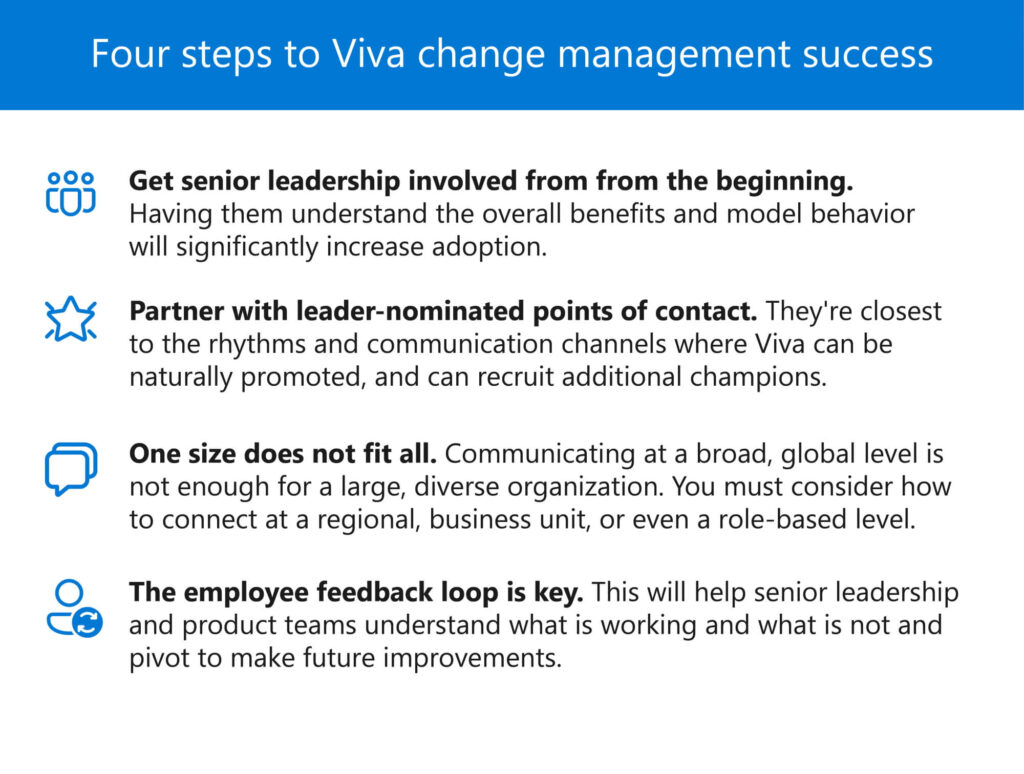 In Microsoft Digital (MSD), our job is to accelerate Microsoft’s own digital transformation through world-class employee experiences. We were thrilled when Microsoft Viva was announced in 2021 as a modern platform dedicated to employee growth, wellbeing, and productivity.
In Microsoft Digital (MSD), our job is to accelerate Microsoft’s own digital transformation through world-class employee experiences. We were thrilled when Microsoft Viva was announced in 2021 as a modern platform dedicated to employee growth, wellbeing, and productivity.
Microsoft Viva was developed based on research showing:
- Employees want to feel strongly connected to their company mission. They want to grow, make an impact, and balance professional and personal life.
- Leaders need a modern way to engage with and develop their employees and to nurture overall wellbeing.
- IT needs to quickly enable experiences that delight while ensuring privacy and accessibility.
During the last year, we’ve had the opportunity to lead the adoption program for Microsoft’s 220,000-plus global employees. Each of us focused on an assigned set of business units within the company, where our goals were to activate sponsorship of Microsoft Viva, drive employee awareness of its benefits, and collect feedback for the product and IT teams to make the experience even better. Here’s what we learned.
Activating sponsors
We know from experience that visible sponsorship from senior leaders is one of the most important factors enabling successful change management. Employees look to their leaders for direction and are pretty good at sensing their level of genuine commitment. When sponsors are active and visible, it sends a clear message that they are committed to the change, and when sponsors go even further and lead by example, their teams adopt the change at an accelerated pace. For these reasons, we start with senior leaders when we mobilize a new adoption program.
Our approach was to understand the leader’s goals, then help them learn where Microsoft Viva could support their goals. There are two themes that were commonly shared: Employees felt they had too many meetings and not enough time for learning. Hearing these challenges, we shared how Viva can support employees with time management. For example, the Microsoft Viva Insights “Wellbeing” feature helps individuals make more time for focused work, and manager insights help managers understand how employees are working so they can better support and coach them. Similarly, to address the desire to foster their employees’ time for learning, we illustrated the benefits of Microsoft Viva Learning, like intelligently creating calendar blocks to complete specific courses.
Once we obtained buy-in, we asked leaders to nominate someone on their team we could work with on a regular basis as a primary point of contact. This made it easier to tee up activities in the business unit since these individuals had a pulse on their team’s rhythm, including all-hands meetings, team newsletters, manager calls, and other mechanisms used for communication. That helped us ensure follow-through when we needed direct sponsor activity, such as inserting Microsoft Viva messaging into talking points at an internal town hall or embedding Viva into a leader’s message sent via Viva Engage, Microsoft Teams, or email. In addition, the primary point of contact helped to identify additional champions in their organization.
The impact of these efforts is compelling: business units where we’ve successfully activated senior sponsors have seen 25 percent greater adoption of Microsoft Viva so far.

Educating employees
At Microsoft, employees can be overwhelmed by the volume of applications. Part of our change management approach has been to ensure employees understand which application to use and how it applies to their specific role. For example, legal may value different features of an application compared to engineering. Some features are more appealing to employees in the US than those in Germany or Singapore. To address this, we provided global, centralized communication and training offerings, complemented by regional and business unit-specific messaging that could be personalized and tailored for role-based or regional interests and norms.
For example, as part of our awareness campaign for Microsoft Viva Insights, we created overviews for individual contributors that highlight features they will find useful. We also provided overviews specific to managers that focus on capabilities designed especially for them. We then asked our regional and business unit leaders to adjust the messaging to foster alignment with local norms, and to conduct regional or business unit training sessions led by champions of those communities.
Listening to employees
The global-plus-local approach had an additional benefit—the diverse network of champions that we built enabled us to gather feedback and requirements to improve the Microsoft Viva experience for all! Experiences such as accelerating Japanese language support in Viva and improving the Microsoft Viva Topics knowledge base were direct results of this approach.
Capturing and acting on employee feedback is critical to improving our products for not only our employees but our customers as well. More details about Microsoft’s approach to employee listening are available in a three-part article series, “Digital transformation through mastery of the employee experience.”
Partnering with HR and Learning
Inside Microsoft, employees are continuously encouraged through internal campaigns to enroll in a new beta, or join a new community, or pilot a new process. Amid this competition for employee attention and mindshare, we conducted targeted campaigns to drive adoption of Microsoft Viva modules, but just as importantly, we nurtured a strategy of embedding Viva into employee processes that would outlive any temporary campaign. The HR and Learning teams were important partners to accomplish this.
The health and wellbeing of our employees is a top priority, and taking time off to rest and recharge is an important aspect to ensure employee wellbeing.
—Rich Kaplan, HR leader, Employee Experiences
Early in the project, we approached HR leadership and asked them to invite every HR team to ask, “How could Viva enhance the service I deliver?” This led to Microsoft Viva being woven into the fabric of many existing HR services and messages.
For example, we collaborated over several months to help HR define how Microsoft Viva Insights could become a valuable new tool for Microsoft people managers. Viva Insights helps managers identify opportunities to improve culture and work-life balance in their team. By officially embedding Viva Insights into a HR’s manager framework, not only did usage increase, but it facilitated Microsoft Viva messaging in their natural rhythms and channels to managers rather than through a temporary campaign.
Now that Viva has taken off, HR leaders of Employee Experiences at Microsoft offered these additional examples:
The health and wellbeing of our employees is a top priority, and taking time off to rest and recharge is an important aspect to ensure employee wellbeing. That’s why we’re including Viva in our Microsoft Benefits mail to remind employees to take time off. Viva insights helps plan time away. Manage calendars, set automatic replies, notify collaborators, and resolve meetings—all in one place. Our training reminders include resources on Viva Learning. Our quarterly manager newsletters include insights on teamwork habits and encourage managers to create team agreements on how they work together to enhance Hybrid harmony. We have embedded Viva organically into many of our existing processes and communications, enabling a more seamless and engaging experience for everyone.
Measuring progress
Defining metrics and sharing progress against those metrics with leaders has played an important role in keeping our sponsors engaged. So far, our primary metrics have been active usage and user satisfaction since these are leading indicators of business value.
For usage, we’ve focused on monthly active usage by Microsoft Viva module and for Viva overall. At the end of calendar year 2022, 90 percent of Microsoft employees were using Viva monthly. For calendar year 2023, we are focusing more on the quality, engagement, depth of usage, and retention to better understand how employees can maximize the overall benefits of Viva.
Regarding measuring user satisfaction, we learned that it’s currently difficult to accomplish in-app, so we have relied on surveys to solicit employee feedback. Recognizing this difficulty, we have collaborated with the Microsoft Viva product engineering team to define in-app enhancements that, in the future, will make it easy for any employee to provide feedback about their experience using Viva.
We know from industry and customer research that the business value of Microsoft Viva is substantial:
- Post-pandemic, 53 percent of employees are more likely to prioritize their health and wellbeing over work, and Viva helps to facilitate employee health and wellbeing.
- Seventy-nine percent of employees experience work-related stress that leads to lack of interest, motivation and effort at work, and Viva helps employees to achieve better balance between work and their personal life.
- Highly engaged employees are 12-times less likely to leave their company than those who are not engaged, and Viva is designed to ensure your employees stay connected and engaged to company culture, learning opportunities, and knowledge in the enterprise.
As a result of these insights and changing workplace expectations, we are in the process of shifting our focus to quantifying the impacts of Microsoft Viva adoption on the productivity, performance, engagement, and personal growth of our employees.

Through sponsorship, education, listening, and measurement, we’re off to a good start at Microsoft, but there are a lot more opportunities in the months ahead. In your own organization, you’ll have unique advantages and challenges when it comes to Microsoft Viva adoption, but here are a few takeaways to get you started:
- Get senior leadership involved from the beginning. Having them understand the overall benefits and model behavior will significantly increase adoption.
- Partner with leader-nominated points of contact who are close to the rhythms and communication channels where Viva can be naturally promoted, and who can recruit additional champions.
- One size does not fit all. Communicating at a broad, global level is not enough for a large, diverse organization. You must consider how to connect at a regional, business unit, or even a role-based level.
- Finally, the employee feedback loop is key. This will help senior leadership and product teams understand what is working and what is not and pivot to make future improvements.
Please reach out on LinkedIn—we would love to learn together how to be successful nurturing an employee experience platform:

Tags: developer tools, digital transformation, Microsoft 365, Microsoft Viva








